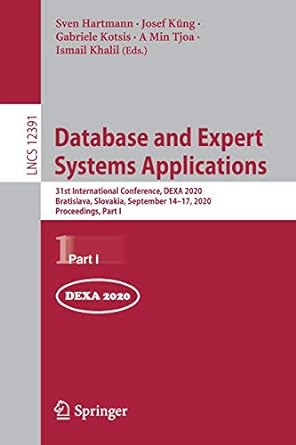Question
Modify the AWT model to: a) report out the largest number of customers enqueued at the same time b) assign the next arriving customer to
Modify the AWT model to:
a) report out the largest number of customers enqueued at the same time
b) assign the next arriving customer to a specific queue based on shortest finish time
c) provide a user interface control to allow user to select shortest finish time or shortest queue for assignments
create the program that is capable of answering these questions. with user inputed data such as the arrival time, service time, how many customers. then asks if the user wants to do it again with y/n:
determine a reasonable reasonable number of queues to use if there are 1000 customers and:
a) The inter-arrival time is 5 and the service time is 5
b) The inter-arrival time is 1 and the service time is 5
c) The inter-arrival time ranges from 0 to 20, and the service time ranges from 20 to 100
d) The inter-arrival time ranges from 0 to 2, and the service time ranges from 20 to 100
Average Waiting Time:
import java.util.Random;
import java.util.Scanner;
public class AveragaWaitingTime {
static int Min(int b[], int a[], int tbt, int r, int n,int large[]) {
int j = 0;
int min = tbt;
int l=0;//finding larger number of process in queue
for (int i = n - 1; i >= 0; i--) {
if (b[i] < min && b[i] > 0 && r >= a[i]) {
min = b[i];
l++;
j = i;
}
}
if(large[0]
large[0]=l;
return j;
}
static int Shortesfinishtime(int n,int p[],int at[],int bt[],int bt2[],int wt[],int tat[])
{
int tbt = 0, large[] = {0};
for (int i = 0; i < n; i++) {
tbt = tbt + bt[i];
}
int time[] = new int[tbt];
int k = 0;
int q2 = 0;
System.out.println("Gantt Chart");
System.out.print("|");
//bt[0] = bt[0] - 1;
for (int i = 0; i < tbt; i++) {
int q = Min(bt, at, tbt, i, n,large);
if (q != q2) {
System.out.print(" p[" + p[q] + "]\t|");
time[k++] = i;
wt[q] = i;
tat[q] = i + bt[q];
}
bt[q] = bt[q] - 1;
q2 = q;
}
time[k] = tbt;
System.out.println();
System.out.print("0\t");
for (int i = 0; i <= k; i++) {
System.out.print(time[i] + "\t");
}
double awt=0;//average waiting time
for(int i=0;i
{
awt=awt+wt[i];
}
awt=awt/n;
System.out.println(" AVERAGE WAITING TIME"+awt);
return large[0];//returning max number of process in queue at same time
}
static int shortestsizetime(int n,int process[],int ptime[],int wtime[])
{
int temp, total=0;
float avg=0;
for(int i=0;i
{
for(int j=i+1;j
if(ptime[i]>ptime[j])
{
temp = ptime[i];
ptime[i] = ptime[j];
ptime[j] = temp;
temp = process[i];
process[i] = process[j];
process[j] = temp;
}
}
}
wtime[0] = 0;
for(int i=1;i
{
wtime[i] = wtime[i-1]+ptime[i-1];
total = total + wtime[i];
}
avg = (float)total/n;
System.out.println("P_ID P_TIME W_TIME");
for(int i=0;i
{
System.out.println(process[i]+"\t"+ptime[i]+"\t"+wtime[i]);
}
System.out.println("Total Waiting Time: "+total);
System.out.println("Average Waiting Time: "+avg);
return n-1;
}
public static void main(String argv[])
{
//variable declaration
int n=100;//number of processes
int p[]=new int[n];
int a[]=new int[n];//to store arrival time of 100 processes
int b[]=new int[n];//to store service/burst/processing time of 100 processes
int b2[]=new int[n];//to store service/burst/processing time of 100 processes
int w[]=new int[n];//to store waiting time of 100 processes
int tat[]=new int[n];//to store turaround time of 100 processes
int i,j;
int quanta;//time slice for round robin
double round_robin,fcfs;
Scanner sc = new Scanner(System.in);
System.out.println("Enter the no of processes");
n=sc.nextInt();
System.out.println("Enter the arrival time");
for(i=0;i<=n;i++);
{
a[i]= sc.nextInt();
}
System.out.println("Enter the Burst time");
for(i=0;i<=n;i++)
{
b[i]=sc.nextInt();
if(b[i]<0){ b[i]=b2[i]=-1*b[i];}
}
Random r= new Random(); //to generate random number
//generating randomly arrival time from 0 to 100
for(i=0;i
{
p[i]=i+1;
a[i]=r.nextInt()%101; //randomly number between 0 to 100 inclusive
}
//randomly burst/processing times from 0 to 100]
for(i=0;i
{
b[i]=(int)r.nextInt()%101; //random number from 0 to 100 inclusive
b2[i]=b2[i];
if(b[i]<0){ b[i]=b2[i]=-1*b[i];}
}
String ans1="";
do
{
int c;
String ans="Y";
//Scanner sc = new Scanner(System.in);
System.out.println("Enter 1: Shortestfinish time algorithm 2: Shortest size algorithm ");
c=sc.nextInt();
if(c==1)
{
System.out.println("Shortest finish time:");
//calling shortest finish time algorithm
System.out.println("Longest number of processes in queue:"+Shortesfinishtime(n,p,a,b,b2,w,tat));
}
else
{
System.out.println("Shortest size:");
//calling shortest size algorithm
System.out.println("Longest number of process in queue:"+shortestsizetime(n,p,b,w));
}
System.out.println("Do you want to continue(y/n)");
ans1 = sc.next();
}while(ans1.equals("y"));
}
}
Step by Step Solution
There are 3 Steps involved in it
Step: 1

Get Instant Access to Expert-Tailored Solutions
See step-by-step solutions with expert insights and AI powered tools for academic success
Step: 2

Step: 3

Ace Your Homework with AI
Get the answers you need in no time with our AI-driven, step-by-step assistance
Get Started


